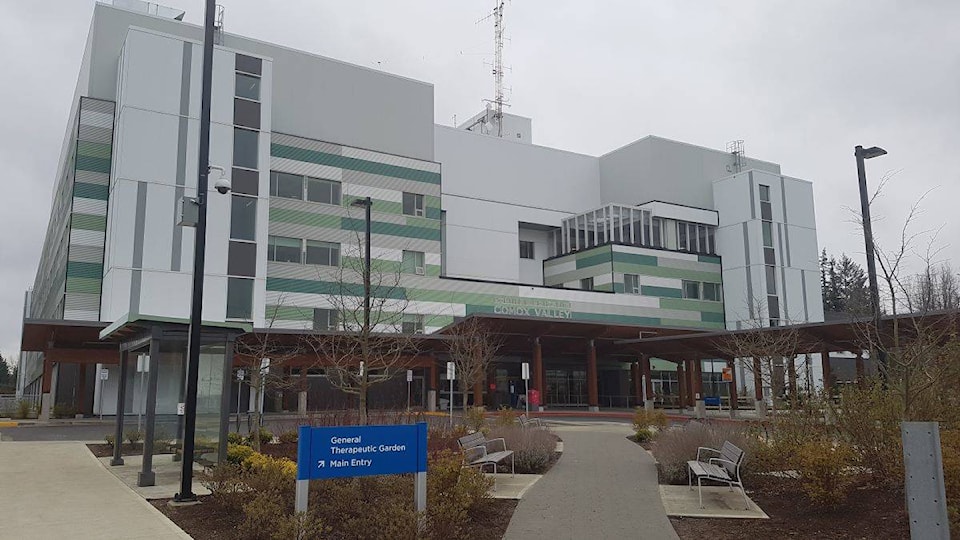The board that oversees raising local revenue for hospital and medical facilities in the Comox and Strathcona regions is pondering how to communicate in the future with Island Health.
Last fall, Island Health had posed the idea of the Comox Strathcona Regional Hospital District (CSRHD) venturing into residential care facilities, as a way to take the pressure of acute care facilities.
The two North Island Hospital campuses opened in 2017 in the Comox Valley and Campbell River, and there have been issues around capacity. The issue is one affecting Vancouver Island in general. In early 2020, an Island Heath fact sheet noted the acute care occupancy rate for the year was 105 per cent, while the target was no more than 95 per cent.
RELATED STORY: Long-term care need pressuring acute care in Comox Valley, Strathcona
In recent months, Island Health has taken part in planning exercises with the CSRHD board, though some board members are opposed to the idea the region could be paying for facilities outside of acute care.
Once again, the issue arose at the latest board meeting on April 8. On the table was a recommendation suggesting, among other things, that chair Charlie Cornfield and vice-chair Doug Hillian be involved with discussions with Island Health — a suggestion that might not sound controversial on the surface but which exposed tensions about the role and future for hospital districts that raise the local portion of capital funding.
The views on the board were anything but unanimous. Edwin Grieve, who sits on the Comox Valley Regional District board, said CSRHD needs to consider re-assessing their arrangement, beyond simply funding hospitals, as a view to reduce demand on the hospitals. Some members were also interested in considering ways to set up a centralized hub as an alternative to the smaller health units around the community, particularly in the Comox Valley.
“I would just like us to remain open to the possibility of improving the quality of health care that occurs outside the actual hospital building,” said Will Cole-Hamilton, a Courtenay board member.
Another topic of discussion was an idea to fund information technology, though there was some uncertainty about whether this qualifies as capital funding, as opposed to operations.
Some such as Campbell River’s mayor, Andy Adams, who worked in the health care sector, have expressed concerns about what could turn out to be a “pay to play” scenario, with regions only getting funds for services such as residential care if they are willing to cover a share of the costs.
Some went further. Gerald Whalley from the Strathcona Regional District suggested the new hospitals were built in Campbell River and the Comox Valley by Island Health, knowing the likely capacity issues and that the situation could leverage CSRHD into taking on more commitments such as seniors’ residential care beds.
“This comes as no surprise to them…. This was orchestrated on their part,” he said, adding he would like the board to contact the province’s Ministry of Health directly about setting an Island-wide policy.
Brenda Leigh, also of SRD, suggested the province’s Ministry of Health step in to take over from the regional health authority, thus eliminating Island Health as the “middleman.” Citing past funding discrepancies, she said, “We have to stand together and fight like crazy to get our share of the health budget…. They are not serving us well.”
The specific motion called for the chair and vice-chair to meet with Island Health two to three times a year in order to advocate for regional interests, cooperate with the health authority toward building the working relationship, establish two-way communication to inform both the public and Island Health and address any issues or interests concerning health care that fall outside the traditional CSRHD mandate.
“It gives us an opportunity for a more direct dialogue with Island Health,” Hillian said. “It doesn’t mean that the chair and vice-chair … go forth and get co-opted by Island Health. It means that they speak on behalf of the board.”
At the end of the discussion, Jim Abram, another SRD director, suggested adding wording to include the provincial government in the communication loop, instead of only Island Health. The amended motion passed, with only Leigh opposing.
“This is just the next step. This doesn’t commit us to changing our mandate,” Cornfield said.
The board also passed a second recommendation to endorse a memorandum of understanding with Island Health. Leigh and Whalley opposed the motion.
mike.chouinard@comoxvalleyrecord.com
Like us on Facebook and follow us on Twitter.
